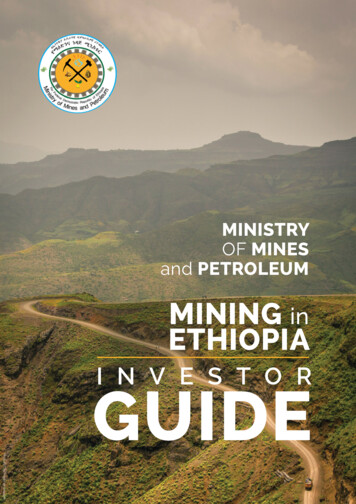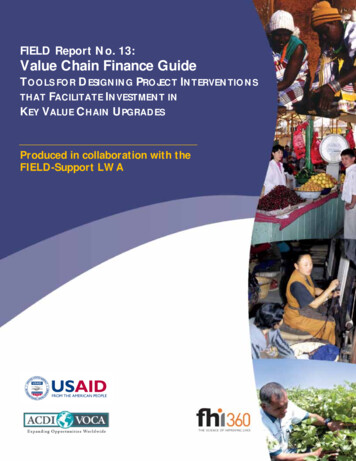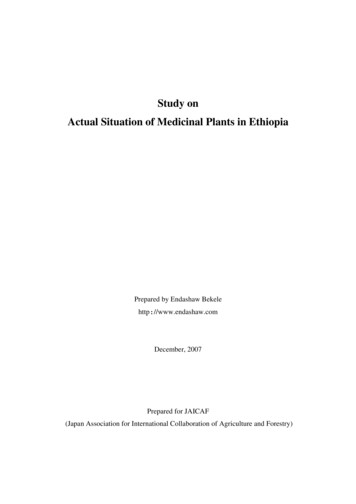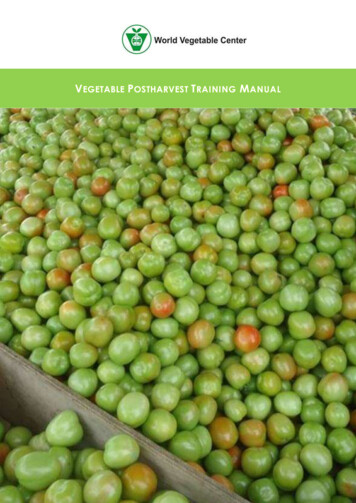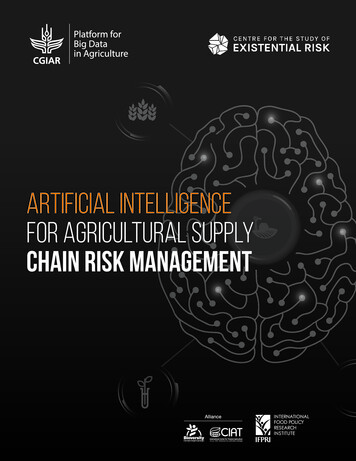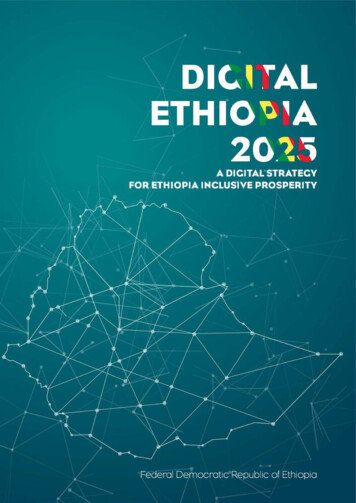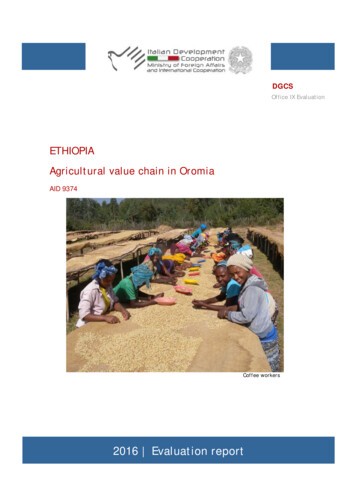
Transcription
DGCSOffice IX EvaluationETHIOPIAAgricultural value chain in OromiaAID 9374PICTURE OF THE PROJECTCoffee workers2016 Evaluation report
Ethiopia – AGRO AID 9374Evaluation ReportAgricultural value chain in Oromia (AID 9374)Evaluation reportCONTENTExecutive Summary5Acronyms and Abbreviations11Part “A”Framework and contextA.1 The agricultural context12A.2 Agriculture in the Oromia region13A.3 Agricultural policy and strategies in Ethiopia14A.4 The value chains: reference model14Part “B”The project Agricultural value chains in Oromia (AID 9374)B.1 Project formulation17B.2 The Intergovernmental Agreement and the Project Implementation Document17B.2.1 Targets and Expected results17B.2.2 The Ethiopian participants in the value chains18B.2.3 Durum and coffee cooperatives19B.2.4 Ethiopian Participants in the Project19B.3 The project components and the performing of the activities20B.3.1 Component A: project implementation in 6 Woreda (AID 9374/01/3)21B.3.2 Component B: Technical assistance (AID 9374/02/4)21Part “C”The evaluationC.1: The desk analysis22C.2 The inception report22C.3 The mission in Oromia and the participatory inquiry22C.4 The data analysis231/48CESECO INTERNATIONAL s.r.l.GB-080816-rev171216
Ethiopia – AGRO AID 9374Evaluation ReportC.5 The evaluation report23C.6. The workshop23Part “D”Project analysisD.1 Relevance and quality of the Logic framework24D.1.1 Relevance24D.1.2 Quality of the logic framework27D.2 Efficiency27D.2.1 Management and monitoring27D.2.2 Execution of the activities28D.2.3 Resources management29D.3 Effectiveness30D.3.1 Durum wheat30D.3.1.1 Durum wheat upgraded seed production31D.3.1.2 Durum wheat cultivation and commercialization32D.3.1.3 Durum wheat value chain structuring33D.3.2 Harenna forest wild coffee33D.3.2.1 Coffee production and commercialization33D.3.2.2 Coffee value chain structuring35D.4 Impact35D.4.1 Durum value chain35D.4.2 Harenna forest wild coffee value chain36D.4.3 Research system, agriculture promotion and the value chain approach37D.5 Sustainability38D.6 Transversal aspects38D.6.1 Gender and social inclusion38D.6.2 Environment39D.6.3 Lifelong upgrade and replication39D.7 Synthesis of the project analysis39D.8 Evaluation charts402/48CESECO INTERNATIONAL s.r.l.GB-080816-rev171216
Ethiopia – AGRO AID 9374Evaluation ReportPART “E”Conclusions, recommendations and lessons learnedE.1 Conclusions41E.1.1 Methodology and project execution41E.1.2 Survey system and agricultural divulgation42E.1.3 Durum value chain43E.1.4 Coffee value chain44E.2 Recommendations and lessons learned45E.2.1 Project methodology and execution45E.2.2 Survey system and agricultural divulgation46E.2.3 Durum wheat value chain47E.2.4 Coffee value chain48Acknowledgements49ILLUSTRATIONS1. The Oromia region2. Ethiopia administrative divisions3. Bale orography4. Value chain model5. Value chain setting up hindrances6. Commercial companies and value chains’ services strengthening7. Partners relationship8. Project activity9. Durum value chain in Bale10. Harenna forest wild coffee value chainTEMPLATES1. Project balance sheet2. Activities carried out during the survey3. Evaluation chart3/48CESECO INTERNATIONAL s.r.l.GB-080816-rev171216
Ethiopia – AGRO AID 9374Evaluation ReportANNEXESAnnex 1: Chronogram and interviewsAnnex 2: LiteratureAnnex 3: Project logic frameworkAnnex 4: Evaluation matrixAnnex 5: Drafts of the interviewsAnnex 6: Activities flow analysisAnnex 7: SWOT analysis of the value chainsAnnex 8: Focus group questionnaireAnnex 9: Cooperatives and assisted cooperatives associationsAnnex 10: Photographic report4/48CESECO INTERNATIONAL s.r.l.GB-080816-rev171216
Ethiopia – AGRO AID 9374IntroductionEvaluation ReportEXECUTIVE SUMMARYThe project Agricultural value chains in Oromia- Aid n. 9374 has been among the overriding actionsenvisaged in the National and Regional Agricultural Development Plan and in the Italy-EthiopiaCooperation Agreement. The main target of the project has been the upgrade of traditional crops inthe Bale region: the durum wheat and the Harenna forest wild coffee.The project funding envisaged a 1.700.000 grant by the Cooperation Department of the ItalianMinistry of Foreign Affairs and International Cooperation. The grant was made of two budget lines: budget-line A, 1.335.000, for realization, supply and field activities in 6 woreda of Bale zone,supporting regional partners and research by the Oromia agricultural research institute; budget-line B, 365.000, for the Italian technical support, carried out by the Italian AgronomicalOverseas Institute.The intergovernmental agreement between Ethiopia and Italy was signed 18/01/2010. The activitiesstarted 18/04/2011 and were to be completed within 18 months. The end date of the project wasthen postponed to 30/04/2016.Analysis of the projectRelevance and quality of the Logical framework. The project is properly embedded in the Ethiopianeconomy development policies and the Italian Cooperation’s strategies. The strengths of the projectare: a) the alignment of the project strategy with the agricultural development policies and thevalorization of the Oromia’s institutions contribution; b) the acquaintance of the Italian experts withthe local partners that allowed exploiting the already existing knowledge and skills in agriculturalresearch and extension; c) the participation of local institutions into the project formulation.The weak points of the project are: a) the lack of an in depth analysis of the local value chain and ofthe legal and economic framework of the context; b) the partial involvement of the private sector inthe identification of the project and the lack of collaboration with others initiatives promoting thewild coffee and seeds value chains; c) the limited funds assigned to the coffee value chain, whencompared to the funds destined to the durum wheat value chain, and especially to its manufacturingand commercialization – although it should be mentioned that in Ethiopia the exchange and sale ofthe agricultural produces is regulated by the State so that it is very difficult to influence it fromoutside.Efficiency: The execution of the project was decoupled from its management this latter assigned toBoFED, OARI and the OAI. Such approach created gaps and obstacles resulting in delays and5/48CESECO INTERNATIONAL s.r.l.GB-080816-rev171216
Ethiopia – AGRO AID 9374Evaluation Reportmonitoring problems. Particularly, the execution of the project along the decentralized approachensured ownership and local participation although it suffered from: i) lack of details in thedocuments and the balance sheet; ii) weak coordination of the local partners; iii) operational hurdlesrelated to the Ethiopian financial and administrative lengthy procedures.Effectiveness: In the 2014-15 season, the durum wheat rural cooperatives increased the cultivated areato 7,434 Ha with an estimated crop of ab. 130.000 q.; the Harenna forest wild coffee grower sold4,500 q. of dried coffee to a leading Italian company while smaller amounts of the produce werepurchased by small coffee roasting outfits thank to Slow Food Foundation.Durum wheat: The introduction of the durum wheat in the area is a double boost for the localagriculture. Not only does the durum wheat contribute to the agricultural diversification, but it alsostrengthens and improves the local crops thanks to the genetic characteristic of this species, a morerust and drought resistant wheat than bread wheat and thus more suitable for cultivation in the Balezone mid-altitude areas. The improvement of the produce in the area would be more durable anddeeper were it possible to produce seed with elite standard characteristics. Such target was notreached due to the limited seed multipliers’ surveillance performed by the SARC and the lack of areliable quality tracking system.Coffee: The location of the Harenna forest wild coffee farming site in the protected area of the MountBale Park, that makes it impossible for the coffee cultivation to expand beyond its presentboundaries, resulted in the project concentrating on the upgrading of the manufacturing and thecommercialization by the local cooperatives and cooperative unions.Impact: Durum wheat. Thanks to the project, the durum wheat value chain has been upgraded: newperspectives have been opened in terms of price setting and supply control by the farmers.Coffee. The same cannot be said of the Harenna forest wild coffee part of the project which has had amore limited effect on the produce value chain due to various reasons. Firstly, the project reachedjust part of the coffee farmers. Secondly, the project improved collection and post-harvest steps(drying, hulling, storage and market access) although it did not affect the relations between thecoffee farmers and the buyers in the stages that precede the commercialization of the harvest, alsodue to the binding trade regulations. Such collaboration would have improved the offer reliability,thus making it more affordable for the purchasers to manage the product quality. It appears that theproject overlooked some key points for the integration of the value chain: i) the set-up of anindependent produce analysis service; ii) the recognition of the specificity of the produce with the6/48CESECO INTERNATIONAL s.r.l.GB-080816-rev171216
Ethiopia – AGRO AID 9374Evaluation Reportissue of a certificate equivalent to the European Protected Designation of Origin; iii) theparticipation of coffee growers to marketing events.Sustainability. The project has strengthened the farmers’ commitment to quality and has bolstered thecapacity of the cooperatives and cooperatives unions in the commercialization of the harvest. Theincome of the farmers and the financial reserves of the cooperatives have increased, in line with theproject target. The incomplete set up of the value chain of the durum wheat and of the Harennaforest wild coffee have reduced the farmers commitment to quality, a key factor for the producesustainability.To conclude, the project has contributed to the strengthening of the farmers’ production capacitiesand to the increase of their income, but, due also to its limited budget, it has not cut into somestructural issues related to the functioning of the value chains, issues that weight on the finalconsumer choice. It is advisable for the further recently financed initiatives to attach moreimportance to such topics.Conclusions, recommendations and lessons learntConclusions1. Coherently with its targets, the project carried on and widened the support to the ABRDP tothe research and promotion of agricultural innovation in Oromia (OARI-SARC) and to SlowFood in their effort of improving the durum wheat and the Harenna forest wild coffee production inthe Bale zone. It also strengthened the durum wheat and the Harenna forest wild coffee value chain’commitment to quality.2. Although, the logical framework of the project mirrored its strategy, the majority of theindicators targets were not numerically defined a fact that did hamper the project monitoringand reporting.3. The lack of an analytic approach to tackle each of the value chain elements, orientation toachieve immediate results and the strong regulation of the farm products trade in Ethiopialimited the mobilization of those resources bound to ease a more structured approach to thevalue chain integration. The harvest commercialization and manufacturing were particularlybiased mainly due to external constraints.4. The support to the farmers’ budget enhanced the farmers’ capacities and skills and those oftheir local partners as well thanks to the direct delivery of innovative upgraded technologyinto the already existing structure. The strict regulatory system of the Ethiopian public7/48CESECO INTERNATIONAL s.r.l.GB-080816-rev171216
Ethiopia – AGRO AID 9374Evaluation Reportsector, in the administrative - financial field, resulted in delays that further built up due to theseparation of the project’s decision centers (Addis Ababa and Florence) from the localpartners.5. The project was flexibly managed and was carried out with a collaborative attitude. Theparticipation was stronger in the durum wheat sector due to the more structuredorganization of the producers (the cooperatives).6. The buildings, the equipment and the other materials supplied by the project strengthened theoperative capacities of the farmers, of the cooperatives and of their partners - also enhancingthe commercialization.7. The exchanges of experiences were favoured by collective meetings and visits to theproduction sites stimulated the farmers to commit to the product quality. The involvementof the industries, of the middlemen and of the providers of the goods would have made suchoutcome deeper and systematic.8. The fact that all and sundry seeds providers flooded the informal market damaged the projectpro-quality commitment: by selling uncontrolled seeds they caused the fall off in quality ofthe produce destined both for the internal and for the international market.9. The harvest promotion activities due to strengthen the bonds between supply and demandestablished profitable relations between the growers and the buyers albeit they did not cutinto the quality of the produce because of the incomplete structuring of the value chains.10. The lack of independent, quality driven laboratories was a further weighted down thecommitment to quality and to the building of a standard crop tracking system, as SARClaboratory is influenced by this center research mandate and involvement in durum wheatinputs supply.11. The project did not cut into the value chain’s coordination mechanism that, together withthe market regulatory system, would have goaded the farmers towards a stronger recentlycommitment to quality.12. The proposed harvest based credit schemes, albeit the involvement of the Rural and urbansavings and credit cooperatives (RUSACCO), did not work properly. The insufficient specificcompetence of the Oromia cooperative bank also limited the credit granting to the farmers.8/48CESECO INTERNATIONAL s.r.l.GB-080816-rev171216
Ethiopia – AGRO AID 9374Evaluation ReportRecommendations and main lessons learnt1. The forecast continuation projects should be based on detailed analyses of the value chains,in order to tackle the needs of each link of the chain and to strengthen the whole of thevalue chain.2. The continuation projects have to include logical framework indicators with numerical targetvalues for the evaluation of the outcomes. Targets should encompass the evaluation in termsboth of quality and quantity of the produce that reaches the final consumers. Themonitoring should comprise the systematization of the indicators template and the draftingof an annual report. These are both foreseen in the Intergovernmental CooperationAgreement, but are missing in this case.3. The continuation projects should be realized together with other initiatives in similar oridentical sectors (for example those financed by the USAID) in order to systematicallycomplete the structuring of the value chains – also without disregarding the analysis of thecommercialization laws and regulations for crops and food in Ethiopia.4. The continuation projects should mobilize a skillful manager with project managementcapacities that should coordinate the partners to focus toward time and administrative andfinancial procedures sparing.5. The cooperative organization in the Bale/woreda area should provide training courses onmanagement to the directors of the cooperatives/unions of cooperatives.6. The continuation projects should also envisage training and technical assistance to the farmmachinery fleet in order to enhance the functionality of combine harvesters.7. The continuation projects should focus on the training and the sensitization of all of theparticipants (industries, middlemen, goods and services providers) on such topics as thevalue chains, the quality and traceability of the produce in order to realize a standardproduce.8. The continuation project should make it a rule for select quality seed companies to pass seedsto a few agricultural contractors, also in the form of cooperatives union, these latter on theirpart to guarantee strict surveillance over the conformity of seeds to predetermined standards.9. The continuation project should promote the involvement of the purchasers in the provisionof technical assistance and produce control services to the farmers in order to identify andremove non conformity causes.9/48CESECO INTERNATIONAL s.r.l.GB-080816-rev171216
Ethiopia – AGRO AID 9374Evaluation Report10. The continuation project should support the value chains’ stakeholders in the creation of anindependent with international standard compliant (ISO 17025) market oriented produceanalysis service. Such service could also make use of the SARC and the Ethiopia commodityexchange (ECX) laboratories once their management autonomy is assured.11. The continuation project should assist the MoARD/BOARD, together with the delegates ofthe value chains and the coordination outfits as the Wheat forum, the Pasta alliance, and theAssociation of the coffee growers, in the drafting of the value chain standards. Suchstandards should be adopted also for the formulation of the development strategies and offor the market self-regulation.12. The continuation projects should be inserted in the frame of other initiatives (for examplethe Agriculture growth program) in the promotion of produce based credit and in the carryingout the sensitization of the suitable financial institutions, provided with agriculture creditexpertise, in order to make them capable of using the credit reinsurance mechanisms.10/48CESECO INTERNATIONAL s.r.l.GB-080816-rev171216
Ethiopia – AGRO AID 9374Evaluation ReportAcronyms and ACCOqQDSSARSARCSPSSWOTUTLUSAIDWoARDWoFEDArsi and Bale Rural Development ProjectSul livello del mareAgriculture Growth ProgramAccordo Intergovernmental AgreementAgricultural Output Marketing Agency of Oromia,Budget LineRegional Bureau of Agriculture and Rural Developmentof OromiaRegional bureau of finance and economic developmentof OromiaCooperative Promotion OfficesConsiglio per la Ricerca Agricola Dipartimento Scienze e Tecnologie Agro-ambientaliFood and Agriculture OrganizationFondazione Slow Food per la biodiversitàGrowth and Transformation PlanEttaroIstituto Agronomico per l’Oltremare (Firenze)International Center for Agriculture Research in DryAreasMinistero degli affari esteri and of InternationalCooperation/ DGCSMinistero degli affari esteri e della cooperazioneinternazionaleMillenium development goalMinistry of agriculture and rural developmentMinistry of finance and economic development ofEthiopiaOromia Agricultural Research InstituteOromia Cooperative Promotion BureauOrganization for Economic Cooperation andDevelopment – Donor activities CommitteeOrganizzazione non governativaPlan for accelerated and sustainable development toend povertyPerson in chargeProject implementation documentAgriculture sector policy and investment frameworkProdotto interno lordoProject steering committeeRural and urban savings and credit cooperativesQuintaleQuality declared seedSemi annual reportSinana agricultural research centerSocietà produttori sementiStrengths – weaknesses – opportunities – threatsUnità tecnica locale (Addis Abeba)United States Agency for International Dev.Woreda office of agriculture and rural developmentWoreda office of finance and economic developmentaslAbove sea levelIAIntergovernmental AgreementARC-QCEDAETAgricultural Research CouncilDepartment of Agro-EnvironmentalTechnologySFFBSlow Food Foundation for BiodiversityHeOAIHectareOverseas Agronomic InstituteMFAIC/IDCAMFAIC–Italian Development CooperationDepartmentMinistry of Foreign Affairs andInternational CooperationMoANRM. of agriculture and natural resourcesNGONon-governmental organizationGDPGross Domestic ProductqQuintalSPCSeeds Production CompanyLTULocal Technical Unit (Addis Abeba)11/48CESECO INTERNATIONAL s.r.l.GB-080816-rev171216
Ethiopia – AGRO AID 9374Evaluation ReportPART “A”Framework and contextA.1 The agricultural contextOromia is the widest of the eight regional subdivisions of Ethiopia (fig. 1). With its 284,538 km2, itspans over about ¼ of Ethiopia (1,126,829 km2). Adana (Nazareth) is its capital city, but its mainadministrative institutions are mainly located in Addis Ababa.Country/Region:Ethiopia/OromiaCapital:de jure Addis Abeba de facto AdamaArea: 284,538 km2Population: (2007): 27,158,471 ab.Density:95 ab/km2Plate 1. Oromia regionIn Ethiopia there are about 700 industrial mills and 20 pasta manufacturing plants, half of which arelocated in Oromia. With an annual pasta output of ab. 50,000 t (2014), the Oromia pasta productioncovers ab. 20/30% of the production of Ethiopia as a whole (150,000 t). Such production howeverdoes not meet the pasta needs of Ethiopia. In 2014, for example, 30,000 t of pasta were imported.While pasta is absorbed into the local market, Oromia Arabica coffee, the main source for foreignexchange in the region, is mainly exported. It grows between 1,400 and 2,000 asl in usually smallerthan 1 ha plots. 2/3 of the national coffee production is grown in Oromia. The farm land in Oromiaregion is subdivided in small family owned plots12/48CESECO INTERNATIONAL s.r.l.GB-080816-rev171216
Ethiopia – AGRO AID 9374Evaluation ReportPlate 2. Administrative regions and zones of EthiopiaA.2Agriculture in the Oromia regionAgriculture is the economic pivot of the Oromia region and the main livelihood and income sourcefor about 90% of its population. The cultivation of grain is concentrated in the valleys and plansabove 1,500 asl in a temperate climate, variable rainfall intensity zone. The agricultural produce isnot locally consumed in full as part of it reaches the national market.The annual coffee production in Ethiopia varies between 200,000 and 300,000 t depending on theweather. Of such production, more than a half comes from Oromia and generates about USD300,000 m (see plate 3).Plate 3. Bale orography13/48CESECO INTERNATIONAL s.r.l.GB-080816-rev171216
Ethiopia – AGRO AID 9374Evaluation ReportA.3 Agricultural policy and strategy in EthiopiaThe project Agricultural value chain in Oromia met the set into the National agricultural developmentplan priorities: The Plan for accelerated and sustained development to end poverty programme (PASFEP). The Joint government – donor rural economic development & food security group, presided by the Ministry ofAgriculture and Rural Development (MoARD), now Ministry of agriculture and natural resources(MoANR) The Arsi and Bale rural development project (ABRDP) completed in 2008. The Ethio-Italian cooperation framework 2008-2011, signed 21/4/2009, that mobilizes the fundsearmarked for the strengthening of the Oromia produce. The project “Improving the sustainability and inclusiveness of the Ethiopian coffee value chain through privateand public partnership”, started by the UNIDO (2016), funded by the Italian Cooperation, Illycaffé and the Ernesto Illy Foundation.A.4 The value chains: reference modelThe value chain model allows a more efficient approach to the production of a good, or theprovision of a service, that meets the needs both of the stakeholders and the consumers. The valuechains in hand encompass two distinct phases:a) production, transformation and commercialization of the produce;b) sale from the producer to the final consumer (bar local sale).The basic aspects of the agricultural value chain (more properly “agriculture and food value chain”)are listed below (pl. 4).14/48CESECO INTERNATIONAL s.r.l.GB-080816-rev171216
Ethiopia – AGRO AID 9374Evaluation ReportPlate 4. Agriculture and food chainThe following plate (pl. n. 5) shows the main hitches relating the transformation of the traditionalfood safety oriented production into a commercial consumer satisfaction oriented production.Plate 5. Hurdles to the value chain strengtheningThe involvement of all of the stakeholders allows the prompt and wide-spread dissemination of theupgrades also ensuring the much needed flexibility to the chain during the transition phases. Thevalue chain strengthening involves the goods and services providers as well thus particularly15/48CESECO INTERNATIONAL s.r.l.GB-080816-rev171216
Ethiopia – AGRO AID 9374Evaluation Reportcontributing to i) the channeling and spreading of the productive resources and above all ii) thereworking and dissemination of information and technology with a streamlining, consumersatisfaction and market oriented effect on the farmers’ work.Plate 6. Agricultural value chains commercial companies and services strengthening16/48CESECO INTERNATIONAL s.r.l.GB-080816-rev171216
Ethiopia – AGRO AID 9374Evaluation ReportPART “B”The project: Agricultural value chain in Oromia (AID 9374)B.1Project formulationThe project Agricultural value chains in Oromia - Aid n. 9374 sets itself into the the Ethio-ItalianCooperation Framework 2009-2011, signed by the Italian Cooperation and the Ethiopian MoFED21/4/2010. The Framework had been conceived by the Local Technical Unit (LTU) of the ItalianEmbassy in Addis Ababa and the Oromia BoFED on the basis of the evaluation report of thesecond phase (2003-2007) of a previous agricultural project named Arsi and Bale Rural DevelopmentProject (ABRDP). The project Agricultural value chains in Oromia, coded AID 9374, was approved bythe Direction Committee of the Italian Development Cooperation Department (MFAIC/IDCD)16/12/2009 with Resolution 151 and was given a 1.700.000 grant.B.2The Intergovernmental Agreement and the Project Implementation DocumentThe Intergovernmental Agreement (IA) between Ethiopia and Italy for the financing of the projectAgricultural value chains in Oromia (AID 9374) was signed 18/1/2010. Annex A of the Agreementcontains the Project implementation document (PID) that analyzes the project context, the strategy, thetargets (paragraph 2.1), the indicators and the expected results (par. 2.3) together with the projectexecution modalities. It also provides guidance to the monitoring and evaluation activities. TheLogic frame is to be found in par. 1.3 of the Funding proposal drawn by the IAO, and source for thePID, annexed to the Funding agreement. The project started 18/04/2011. 11/05/2012 aprorogation was asked to 30/04/2014 and, again, to 30/05/2015. 31/03/2015 the BoFED askedfor a further time extension to 30/10/2015. 13/11/2015 a new deadline was then set to 30/04/2016under request of the BoFED.B.2.1 Targets and Expected resultsSuch were the Targets, the Expected Results and the Project Indicators that were shown in theLogic framework (see annex 3) and in Sections 2.1 and 2.3 of the PID:General Target: contribute to the reduction of poverty and to the promotion of development in theOromia region by an intervention in the agricultural sector (Millennium development goal n.1 target n.1).Specific Target: increase the rentability of the Bale’s traditional produce and particularly the durumwheat and the Harenna forest wild coffee through the bolstering of specialized agricultural outfits17/48CESECO INTERNATIONAL s.r.l.GB-080816-rev171216
Ethiopia – AGRO AID 9374Evaluation Reportand the support to the farmers associations with the aim of upgrading the produce’s quality and theproduce commercialization.Expected ResultsDurum wheat Value Chain1.The regional check and research system strengthened and geared towards the new challenges ofseeds certification and valorization of the durum.2.The district agricultural institutions’ (WoARD) dissemination capabilities regarding the newadvancements in technology strengthened together with their sustain to the cooperativessystem;3.First and second level durum production and seeds multiplication cooperatives for the industrycoordinated.4.The business relationships among the cooperatives and the transformation industries improvedby the adoption of futures contracts.Harenna forest wild coffee Value Chain1.Harenna forest wild coffee producers association founded and strengthened, its productinternationally recognised and exported.2.Districtual Agriculture and Rural Development’s (WoARD) capabilities strengthened.3.Harenna coffee cooperatives’ capabilities strengthened and upgraded with the adoption ofquality protocols and environment sustainable management.B.2.2 The Ethiopian participants in the value chainsThe activities were assigned to the participants in the value chains (sects. 3.1 and 3.3 of the PID).National institutions partners in the project: Ministry of finance and economic development of Ethiopia (MoFED); National bank of Ethiopia.Regional institutions: Regional Bureau of Finance and Economic Development of Oromia (BoFED); Regional Bureau of Agriculture and Rural Development of Oromia (BoARD); Oromia agricultural research institute (OARI), with its Bale branch (Sinana agricultural research center,SARC); Oromia cooperative promotion bureau (OCPB) through the outfit in Bale and the woreda; Oromia trade and market development bureau OMTDB).18/48CESECO INTERNATIONAL s.r.l.GB-080816-rev171216
Ethiopia – AGRO AID 9374Evaluation ReportThe national, locally acting institutions: The Woreda institutions – Agricultural institutions (Woreda office of Agriculture and RuralDevelopment, WoARD) and Financial institutions (Woreda office of Finance and Economic Development,WoFED), and Cooperatives Organization (Cooperatives promotion office, CPO).B.2.3 Durum wheat and Coffee CooperativesThe agricultural cooperatives selected were 15 for the Durum and 12 for the Coffee, all based inBale. Such cooperatives are active in 5 woreda for the durum and in 1 for the coffee. Thecooperatives adhere to the cooperatives union (3 for the durum and 1 for the coffee).B.
E.1.3 Durum value chain 43 E.1.4 Coffee value chain 44 E.2 Recommendations and lessons learned 45 E.2.1 Project methodology and execution 45 E.2.2 Survey system and agricultural divulgation 46 E.2.3 Durum wheat value chain 47 E.2.4 Coffee value chain 48 Acknowledgements 49 ILLUSTRATIONS 1. The Oromia region 2. Ethiopia administrative divisions 3.
